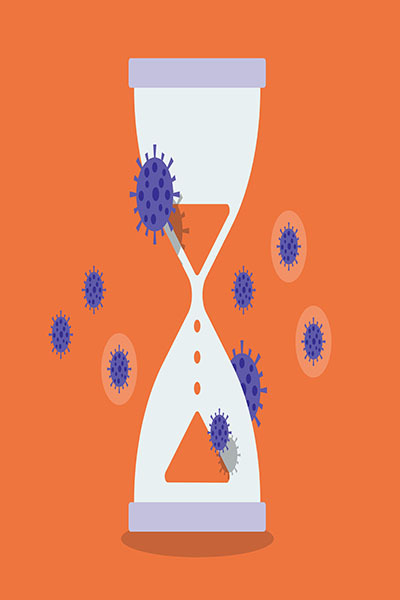
HICprevent
This award-winning blog supplements the articles in Hospital Infection Control & Prevention.
HIC at 50: Infection Prevention in a Pandemic Era
January 20th, 2023

By Gary Evans, Medical Writer
In the 50th year of publication of Hospital Infection Control & Prevention (HIC), we find ourselves in a perilous world where the emergence of viral infections and antibiotic-resistant organisms seems to be accelerating.
Infection preventionists (IPs) have weathered the storm of the COVID-19 pandemic for three years and are trying to rebuild and strengthen a field that has proven efficacy in preventing healthcare-associated infections (HAIs) and protecting patients.
In addition, the Association for Professionals in Infection Control and Epidemiology (APIC) is preparing its members for emerging and re-emerging infections, says Pat Jackson, RN, BSN, CIC, APIC president.
“The reality of our future is that there are likely going to be other pandemics and emerging infections for all the reasons we have talked about — infringing on animal habitats, climate change,” she says. “We want to make sure that we can respond nimbly, so we have formed an emerging infectious disease taskforce. We are creating some just-in-time playbooks to help our members with tools to respond to infections like measles, highly pathogenic avian influenza, Ebola, and polio.”
Consider these potential viral pandemic and epidemic pathogens that have emerged in this young century, as covered in HIC.
2002
- The first cases of severe acute respiratory syndrome (SARS-1) are discovered in China. The coronavirus likely jumped from Chinese horseshoe bats into palm civet “cats” sold in exotic animal markets.
2003
- SARS-1 spreads globally to 8,098 people, resulting in 774 deaths before it disappears with the last cases in 2004. In North America, hospitals in Toronto were hit particularly hard, resulting in 438 cases and 44 deaths — including three healthcare workers.
2005
- The legendary 1918 influenza A H1N1 “Spanish flu” is recreated by public health investigators, with some of the genomic material coming from an Inuit woman buried in the permafrost of an Alaskan village wiped out by the pandemic virus.
2007
- Avian influenza H5N1 kills poultry in outbreaks in countries around the world. Bird flu is widely considered a possible pandemic virus, but it never develops the ability to effectively transmit between humans.
2009
- A pandemic of novel influenza A virus (H1N1pdm09), with genetic elements of swine, bird, and human, emerges in the United States and spreads globally. Although mild by pandemic standards, it shows the potential reach of such pathogens by infecting more than 1 billion people.
2012
- Middle East respiratory syndrome (MERS), a coronavirus that can cause severe respiratory infection and death, is found in Saudi Arabia and Jordan. Although likely of bat origin, MERS establishes a reservoir in camels in the region. With rare exceptions, it does not emerge from the Middle East in any sustainable way.
2014
- An Ebola virus outbreak begins in West Africa, eventually becoming the largest ever with more than 28,000 cases and 11,000 deaths over the following two years. Some IPs volunteer to help and head to Africa. The index case is thought to be a 2-year-old boy who frequently played in a hollow tree in a rural region of southeastern Guinea. When the tree caught fire in 2014, a horde of Angolan free-tailed bats flew out.
- Ebola in America: A traveler from Liberia infects two U.S. nurses in Dallas. Both survive, but the fear of Ebola in the United States is palpable. In some instances, it goes beyond science, becoming irrational and stigmatizing.
2016
- The mosquito-borne Zika virus outbreak spreads throughout the Americas, causing horrific birth defects. U.S. IPs emphasize that standard precautions and safe injection practices will prevent transmission in healthcare settings.
2019
- The first cases of SARS-CoV-2 infection are reported in Wuhan, China.
2020
- The first cases of COVID-19 are identified in the United States. The first case of U.S. person-to-person spread is reported Jan. 30, 2020. Approximately two years and four months later, the United States reaches the grim milestone of 1 million dead, although epidemiologists say it likely was reached months earlier because of uncounted cases of SARS-CoV-2.
2021
- Investigative journalism project estimates of about 3,000 healthcare worker deaths because of COVID-19. The Centers for Disease Control an Prevention (CDC) estimate is about 1,500. A bioethicist charged by government health officials to find out the number tells HIC, “We don’t know … we don’t have standardized reporting systems.”
2022
- In an unprecedented move for what was once the most vaunted public health agency in the world, the CDC admits multiple errors and mistakes in responding to the pandemic.
For more on this story, see the next issue of Hospital Infection Control & Prevention.
Gary Evans, BA, MA, has written numerous articles on infectious disease threats to both patients and healthcare workers. These include stories on HIV, SARS, SARS-CoV-2, pandemic influenza, MERS, and Ebola. He has been honored for excellence in analytical reporting five times by the National Press Club in Washington, DC.
